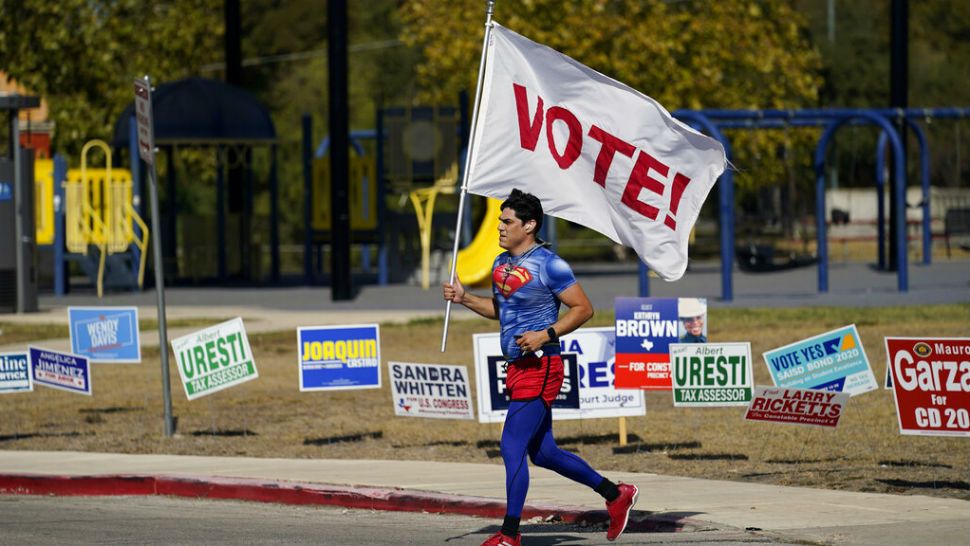TEXAS — While national results in the U.S. presidential race were still being counted, Republicans held on to power in statewide and local races in what was one of the most competitive election years in recent state history. Meanwhile, Pres. Donald Trump was the projected winner in Texas late Tuesday night, according to Associated Press projections.
Democrats went into election night hoping to win in down-ballot races to solidify what has been a blue wave turning the Lone Star State more purple with each subsequent election year. Texas Democrats made serious gains in the 2018 midterm elections as population growth and demographic changes pumped new voters into their ranks.
Polls going into Tuesday showed Trump running neck-and-neck with former Vice President Joe Biden, and, in some cases, trailing the Democratic challenger. Record turnout in early voting surpassed the overall 2016 turnout in Texas and raised Democrats’ hopes that this year they could flip the State House and possibly vote for the first Democratic president in the state since 1976.
Both parties ran a successful campaign to register voters, but Democrats had hoped that the large showing of early voters would put the votes in their favor.
In the end, Republicans staved off the Democratic challenge and kept control of both chambers of the state Legislature. Democrats needed to flip nine seats in the State House to gain back the majority, something they have not had since 2001. Votes were still coming in late Tuesday showing Democrats retaining the 67 seats they had but not succeeding to flip any additional seats in their favor.
Across the state, election observers reported no major incidents at the polls on Tuesday, although some polling stations reported long waits. However, many polling stations reported swiftly moving lines, perhaps because the state had already recorded more than 10 million voters who had cast their ballots in three weeks of early voting.
Earlier in the week, however, a federal judge dismissed a last-minute challenge from Republicans trying to get 127,000 ballots cast at drive-through polling centers in Harris County disqualifiend.
In a closely watched U.S. Senate race, Republican incumbent John Cornyn fended off a strong challenge from Democrat M.J. Hegar. Cornyn, a three-term incumbent, had in the waning weeks of his campaign tried to distance himself from the president, as polling showed many Republican suburban voters turning away from Trump, a national trend that threatened to unseat many Republicans in tight races.
Hegar had attracted voters in some of the areas seeing Texas’ largest population and political shifts – the suburbs – as well as in areas where Democrat Beto O’Rourke won two years ago in his ultimately failed challenge to unseat Texas’ other U.S. senator, Ted Cruz.
Cornyn beat Hegar by almost 10 points, 53.6% to 43.9% of the vote.
As the U.S. looked increasingly at Texas as a battleground state for the White House and tight U.S. Senate races, national Democrats raised millions of dollars to fund the campaign of Hegar, a former Air Force helicopter pilot who narrowly lost a U.S. House race two years ago.
Hegar conceded Tuesday night, saying, "I know our fight here in Texas is far from over."
Democrats did not manage to pick up any U.S. congressional seats to increase the Texas sizable Republican representation in Washington. In what was seen by many political analysts as the state’s true toss-up race, Democrat Wendy Davis, a former state senator and gubernatorial candidate, lost to one-term Republican incumbent Chip Roy in Texas’ 21st District.
Republicans held on in two other hotly-contested races that the Democrats had targeted as possible flips. Republican Sheriff Troy Nehls of Fort Bend County outside of Houston comfortably beat Democrat Sri Preston Kulkarni for Texas’s 22nd district — a seat previously held by Republican Rep. Pete Olson, who retired.
In North Dallas and part of Irving, the 24th District seat was closely watched as it was seen as a bellwether for what is happening in the state’s population changes. The area has seen a large increase of minorities moving into the district, changing the demographics of what was once a mostly white area. In that race, former Irving mayor, Republican Beth Van Duyne, edged out Democrat Candace Valenzuela, a school board member who would have been the first Afro-Latina member of Congress.
Texas Senate Republicans lost one seat Tuesday night in District 19, a large district that includes parts of south San Antonio and stretches toward the border with Mexico. The seat was the only one in the upper chamber to flip as Democrat Roland Gutierrez unseated Republican Pete Flores, who shocked many observers when he won the seat vacated by Sen. Carlos Uresti, D-San Antonio, who resigned in 2018 after 11 felony convictions.
Gov. Greg Abbott, a Republican who was reelected in 2018 to a second term, earlier this week said “It’s not going to happen” in response to Democrats’ drive to turn the state blue and end the Republicans' trifecta of power in the state government.
On Tuesday night, as results came in pointing to Republican wins up and down the ballot, Abbott tweeted his thanks to campaign volunteers and workers, saying, “Texas DID stay Red,” he tweeted. “Every statewide race and the Texas House and Senate remain Republican. God Bless Texas.”
Digital Journalist Eric Griffey contributed to this story from Fort Worth.



